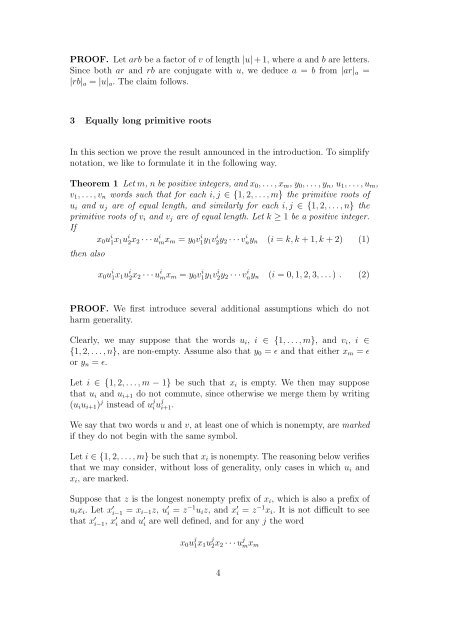On systems of word equations with simple loop sets
On systems of word equations with simple loop sets
On systems of word equations with simple loop sets
You also want an ePaper? Increase the reach of your titles
YUMPU automatically turns print PDFs into web optimized ePapers that Google loves.
PROOF. Let arb be a factor <strong>of</strong> v <strong>of</strong> length |u| +1, where a and b are letters.<br />
Since both ar and rb are conjugate <strong>with</strong> u, we deduce a = b from |ar| a =<br />
|rb| a = |u| a . The claim follows.<br />
3 Equally long primitive roots<br />
In this section we prove the result announced in the introduction. To simplify<br />
notation, we like to formulate it in the following way.<br />
Theorem 1 Let m, n be positive integers, and x 0 , . . .,x m , y 0 , . . .,y n , u 1 , . . .,u m ,<br />
v 1 , . . ., v n <strong>word</strong>s such that for each i, j ∈ {1, 2, . . ., m} the primitive roots <strong>of</strong><br />
u i and u j are <strong>of</strong> equal length, and similarly for each i, j ∈ {1, 2, . . ., n} the<br />
primitive roots <strong>of</strong> v i and v j are <strong>of</strong> equal length. Let k ≥ 1 be a positive integer.<br />
If<br />
x 0 u i 1 x 1u i 2 x 2 · · ·u i m x m = y 0 v i 1 y 1v i 2 y 2 · · ·v i n y n (i = k, k + 1, k + 2) (1)<br />
then also<br />
x 0 u i 1x 1 u i 2x 2 · · ·u i mx m = y 0 v i 1y 1 v i 2y 2 · · ·v i ny n (i = 0, 1, 2, 3, . . .) . (2)<br />
PROOF. We first introduce several additional assumptions which do not<br />
harm generality.<br />
Clearly, we may suppose that the <strong>word</strong>s u i , i ∈ {1, . . ., m}, and v i , i ∈<br />
{1, 2, . . ., n}, are non-empty. Assume also that y 0 = ǫ and that either x m = ǫ<br />
or y n = ǫ.<br />
Let i ∈ {1, 2, . . ., m − 1} be such that x i is empty. We then may suppose<br />
that u i and u i+1 do not commute, since otherwise we merge them by writing<br />
(u i u i+1 ) j instead <strong>of</strong> u j iu j i+1.<br />
We say that two <strong>word</strong>s u and v, at least one <strong>of</strong> which is nonempty, are marked<br />
if they do not begin <strong>with</strong> the same symbol.<br />
Let i ∈ {1, 2, . . ., m} be such that x i is nonempty. The reasoning below verifies<br />
that we may consider, <strong>with</strong>out loss <strong>of</strong> generality, only cases in which u i and<br />
x i , are marked.<br />
Suppose that z is the longest nonempty prefix <strong>of</strong> x i , which is also a prefix <strong>of</strong><br />
u i x i . Let x ′ i−1 = x i−1z, u ′ i = z−1 u i z, and x ′ i = z−1 x i . It is not difficult to see<br />
that x ′ i−1, x ′ i and u ′ i are well defined, and for any j the <strong>word</strong><br />
x 0 u j 1x 1 u j 2x 2 · · ·u j mx m<br />
4
















